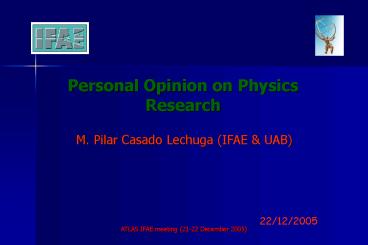A1262288184Boqbu - PowerPoint PPT Presentation
1 / 17
Title:
A1262288184Boqbu
Description:
work in a new regime with. very high rate and large. events. ... of Interest data (~2%) with full granularity and combines information from all ... – PowerPoint PPT presentation
Number of Views:58
Avg rating:3.0/5.0
Title: A1262288184Boqbu
1
Personal Opinion on Physics Research
M. Pilar Casado Lechuga (IFAE UAB)
22/12/2005
2
Outline
- Some HEP experiments (future)
- Trigger and DAQ system of ATLAS
- Physics analyses
- Tau physics analyses in ATLAS
- Conclusion
3
HEP Experiments ALICE
- Study nucleus-nucleus
- interactions at LHC energies.
- A new phase of matter (quark-
- gluon plasma) is expected.
4
HEP Experiments LHC-b
- Experiment to study CP
- violation in the B meson system,
- by determining properties of
- certain processes and comparing
- with their CP conjugates.
5
HEP Experiments CMS
- Multipurpose experi-
- ment for
- Higgs physics
- Supersymmetry
- Heavy ion physics.
6
HEP Experiments ATLAS
22 m
Weight 7000 T
44 m
- Also, a multipurpose detector.
7
What the Trigger DAQ system have to face in
future HEP Exp.
- ATLAS and CMS have to
- work in a new regime with
- very high rate and large
- events.
8
Trigger DAQ system of ATLAS (I)
- LVL1 decision made with calorimeter data with
coarse granularity and muon trigger chambers
data. - Buffering on detector
- LVL2 uses Region of Interest data (2) with full
granularity and combines information from all
detectors performs fast rejection. - Buffering in Read-Out-Buffers (ROBs).
- EventFilter refines the selection, can perform
event reconstruction at full granularity using
latest alignment and calibration data. - Buffering in Event Builder
2.5 ms
10 ms
sec.
9
Trigger DAQ system of ATLAS (II)
LVL1 finds an EM cluster in the calorimeter or a
muon track in the external muon spectrometer
LVL2 uses LVL1 info to define a region
LVL2 accesses data for that region (a few percent
of the total)
10
Physics Analyses (I)
- Based on a deep knowledge of the detector.
- Physics coverage.
- Granularity.
- Electronics of the detector.
- Calibration of the data.
- Software is also fundamental.
- Online software.
- High Level Triggers.
- Offline reconstruction.
- Physics analyses.
11
Physics Analyses (II)
- Some relevant physics analyses with taus in the
final state (prioritized list) - A?tt?electron hadron
- Production of charged Higgs with top
- A?tt?hadron hadron
12
Tau selection
- Possible ways of selecting taus
- In this case, trigger on electron or muon.
- Channel considered here
A/Z-gttt-gtelectron hadron (25 )
n
t
(1)
n
37
lepton
- Use hadron tau trigger.
- Will present here situation in LVL2.
- Important Physics channel
A/Z-gttt-gthadron hadron (46 )
n
t
(2)
63
hadrons
13
EM Tau selection at LVL1
- EM and Tau Trigger at LVL1 have many
similarities - The code for both triggers is executed in the
same chip. - The size of the region is a 4x4 tower in both
cases. - The cluster is formed using the central part of
the EM calo.
- Differences
- Taus use the inner part of the EM and the
hadronic calo for the cluster. - The isolation region is different for EM and
Taus.
14
Electron tau selection in the HLT
Electron trigger
Refine LVL1 position
signal
background
Shower shape variables
Energy of the cluster
The whole event is available
Calorimeter
LVL2
Track reconstruction
Bremsstrahlung recovery
EF
Cluster to track matching in (Dh, Df)
More precise calibration and alignment constants
Inner Detector
15
Present situation in A?tt?e hadron
- To evaluate the efficiency of electron isolated
trigger (e25i) with respect to offline
reconstructed electrons, we use A?tt?e hadron at
low luminosity. - Have plotted efficiency of the e25i trigger as a
function of pT of the electron (black) and pT of
the tau (red). - For the electron case, the turn-on can be
clearly seen between 20 and 30 GeV. - For the taus, the e25i trigger does not get it
maximum efficiency until pT70 GeV.
- Electron - Taus
- The trigger rate of e25i at low
- luminosity is 32 Hz (50 comes
- from real electrons W?en, Z?ee
- e from b, c decays.)
- The trigger rate of t(35)xET(45)
- at low luminosity is 5 Hz.
16
Hadron tau selection in the LVL2
Hadron Tau trigger
Plots from offline, where R200 for e 50
Refine LVL1 position
Energy from inner outer region of the em and
had. calo
Em radius
LVL2
- Taus - Jets
Width in energy deposition
Isolation fraction
Number of tracks in ID
17
Conclusion
- Understanding the detector is fundamental for
physics analyses. - The knowledge of the software is also crucial.
- In tau analyses one can use various types of
selections. Prioritized list - A?tt?electron hadron
- Production of charged Higgs with top
- A?tt?hadron hadron































